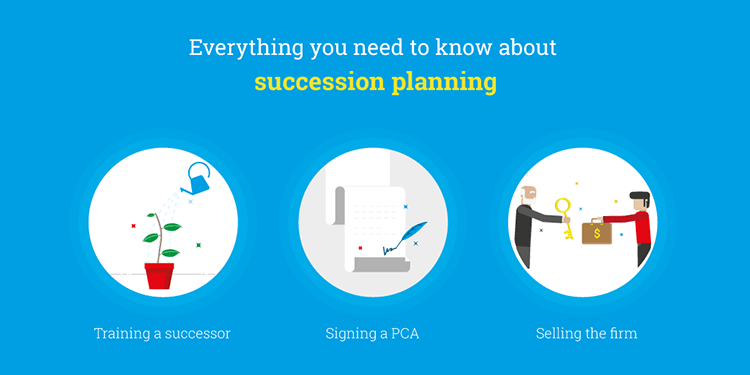Running your accounting firm all by yourself sounds cool, but let’s face it: you won’t be able to run your business forever. Everybody has to face retirement, even accountants and financial advisers.

Your organization has a reputation to maintain, even after your time as founder or CEO has passed. The future of your accounting firm after your departure is very real, and it’s important that you plan ahead for it, starting right now.
This article on succession planning discusses the importance of leadership continuity for your accounting firm, along with various methods by which you can ensure as hassle-free a succession process as possible.
What is succession planning? Why is it important?
When we talk about succession planning, we are referring to the process of transitioning ownership of your firm to another person or firm. Succession usually occurs either when the founder or owner of the firm decides to retire, or when they cannot continue to manage their responsibilities due to unavoidable circumstances.
According to a study done in 2014, close to 32% of financial advisers are likely to retire in the next ten years. Even though that date may seem far off, your retirement time will arrive before you know it, and it’s important that you don’t leave your organization without a roadmap for what to do next. As an owner of the accounting firm, you are the person who is most familiar with your organization’s values and the principles on which you’ve built the firm. As such, it is important that you dedicate your time and energy towards creating a solid foundation for your firm’s future once you’ve retired.
Success in succession
While it might sound daunting, the succession process doesn’t have to be an administrative headache. You can make the process easier in several ways: by training a successor, creating and signing a PCA (Practice continuation agreement), or even selling ownership of your firm. In the next sections, we’ll be unpacking each of these methods so you can choose which succession path is best for your business.
Training a successor
It may not be easy to hand over your firm to another person, but one of the best ways to achieve leadership continuity after your retirement is to find and train someone to become your successor. Although this method will require a significant amount of time on your part, your firm will be better off in the long run if the new leader of your firm is somebody you, as the current owner, have properly prepared for the job.
If you’re planning to retire five or ten years from now, you’ll want to start looking for ideal candidates to be your successor. Your successor can be anyone; it could be someone from your family, or it could be someone whose work you trust, like a highly-skilled and experienced person from your firm. The challenge is to identify the right person for the job.
It is important that, before choosing your candidate, you take a number of critical factors into consideration. Some questions worth asking about your candidate include:
- Will my employees accept my successor?
- Will they be ready to take the leadership role within the planned time?
- Do they have the same vision for my company as me?
- How would they handle a problem in my absence?
- Will they value the culture of the company like I do?
In addition to selecting your successor, you’ll also need to create a long-term plan to prepare them for the leadership role. We’ve listed a few points to give you some general guidelines that you and your successor should follow when planning for a change in management.
Decide on the transition period
Decide on how much time you have left to prepare your candidate. It can take as little as three years, or as many as ten. When planning this timeline, be sure to keep your candidate’s learning speed in mind, as this will be a major determining factor in the length of the transition period. Create a list of the skills and responsibilities you want your successor to learn and come up with appropriate time frames for mastering each skill set.
When making this plan, be sure to stick to realistic deadlines. Rushing this process will leave you with insufficient time to prepare your successor, which can easily lead to frantic and poor decision-making. Remember, dedicating plenty of time to planning your succession will make your transition process smoother and your customers happier.
Set small goals
You did not get where you are today in your business with a single leap of Herculean effort; similarly, you can’t expect your successor to learn everything about how to run your organization overnight. List the responsibilities and projects that your successor will need to handle and break them down into smaller, more manageable tasks. Set milestones so your successor can prepare for one project at a time. By taking more thoughtful, measured steps when training your successor, you will help them evolve and become a better leader.
Encourage Shadowing
Encourage your successor to shadow you, or engage in on-the-job learning, until it’s time for you to retire. Shadowing you on a regular basis will give your successor a chance to understand the roles and responsibilities of the job. Allow them to be part of your business meetings, client visits, etc. Have regular conversations with your candidate to discuss what they have learned at regular intervals. This will help keep you and your successor on the same page, as well as give you a chance to guide them in the right direction.
Open up
Amidst all the hustle and bustle of teaching someone how to be a good leader, make sure you also talk with your candidate about what the firm means to you and the principles on which it was built. Show them what the priorities of your firm are, and discuss your success and failures during your time as firm owner. These conversations will teach your successor much of what it truly takes to run a firm like yours: how to make effective decisions as a business owner, how to manage various teams, and so much more.
Welcome new ideas
One of the greatest perks of having a successor take over your company is the new perspective that this person brings to the table. Newcomers can often look at both your company and the industry with fresh eyes, allowing for creative changes and developments in your business. By allowing your successor to take the reins in certain areas before the succession process is complete, you’ll be able to see how well your chosen candidate works in shaping the future of your firm.
If you do not have plans or haven’t chosen the right candidate to be your successor, you could opt for a Practice Continuation Agreement (PCA).
Signing a Practice Continuation Agreement (PCA)
A Practice Continuation Agreement (PCA) acts as an insurance policy to protect your firm’s practice. In the event of death or physical/mental disability, a PCA will allow another firm or individual to manage your organization and serve your clientele in your absence. It takes time to set the conditions for a PCA, but this can be a very effective strategy if you hadn’t planned on mentoring a successor. Here are a few key points that will help you to set a PCA that works for your accounting firm.
Choose the right company
In the event of a transition, your clients shouldn’t feel that the operations are done by another person or firm. Create a list of organizations that you think are capable of pursuing your firm’s practice. While making this list, make sure you take into consideration the type of clientele you handle, the location of the firm with whom you wish to sign the PCA, their rates for these services, the price of the contract, etc. This will allow you to narrow down your choices and come to a decision sooner.
Create a practice profile
Once the PCA has been initiated between you and the partner company, be sure to create a practice profile, a set of documents to guide the new firm, for your mutual reference. These documents should have all the essential information your stand-in firm needs to keep your business operations running smoothly, including the types of services your organization offers, credentials to access your firm’s client base, operating procedures for ongoing projects, etc. This will get the new firm up to speed as quickly as possible when they take over your firm’s practice so that there’s no decrease in quality of service during the transition.
Check periodically
Practice continuation agreements are signed for brief periods at a time, usually no more than a year or two. Before renewing your contract, make sure you check in with your stand-in company and their status as your organization’s temporary leader. They might have revised the charges, or they may no longer be in a position to serve your clientele. Having a discussion with the firm before renewing the PCA can help you plan your next moves accordingly.
Selling the firm
If none of the above plans works for your situation, your other option is to sell the ownership of your firm to another person or company. Because this is such a significant decision, it’s best to prepare to sell by arming yourself with all the necessary information about buyers, your firm’s worth, and so on. Below we’ve outlined some of the key actions you’ll want to take before selling your business.
Set the price
After you’ve decided to sell your firm, hire an analyst to evaluate your firm’s worth, and prepare a list of potential buyers who would be interested in acquiring your business. Consider the current market conditions and the valuation of your firm when you zero in on a price to quote to buyers.
Get organized
Before you approach any potential buyers with an offer, make sure that all your financial records are in order. Also, we recommend that you have all your client information in one place, as it would be crucial to be as prepared as possible in the event of an immediate transferral of firm ownership. You can use a unified system, like a CRM, to accomplish this task.
Think about your future in the firm
Before talking to potential buyers, decide on what your role in the firm would be after selling it. This new position could range from being an honorary position among the board of directors to being a consultant. Regardless of the specific role, make sure you clearly communicate your expectations of your post-retirement involvement to your buyer.
Talk to your employees
After signing the deal with the buyer, discuss the decision with your staff. Talk to them about why you had to make the decision and set clear expectations for the upcoming months in terms of growth, changes in the organization’s structure, and so on. This will give your teams enough time to adapt to the new management
We know that the decision to sell your firm is never an easy one, but you can prepare yourself and your company for this major change. If you follow the above steps, you’ll set yourself up for a healthy ownership transfer.
In the next blog post, we will discuss another crucial component of succession planning: the transfer of your entire client database to your successor. We’ll also be highlighting the use of CRM systems in an accounting firm and discuss the ways it can be used to simplify the process of succession planning.
